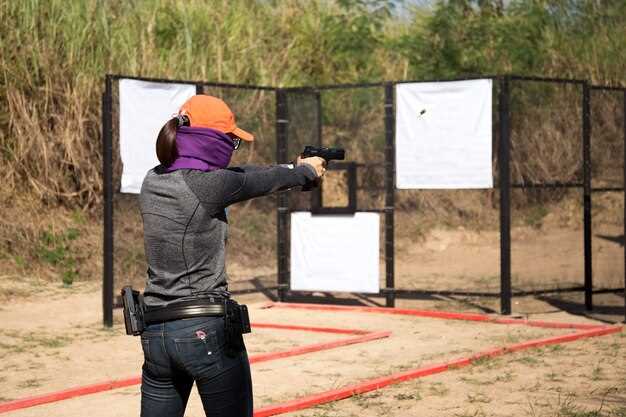
How to get started in competitive shooting

Competitive shooting is a thrilling sport that combines precision, control, and mental focus. Whether you are a seasoned marksman or a newcomer to the discipline, understanding the fundamentals is essential for success. This article aims to provide valuable tips and advice to help you navigate the exciting world of competitive shooting.
As you embark on your journey in this competitive landscape, it’s crucial to grasp the basic techniques and strategies that will enhance your performance. From mastering your stance and grip to refining your sight alignment, each aspect plays a pivotal role in achieving accuracy and consistency.
In addition to technical skills, mental preparation is equally important in competitive shooting. Learning how to manage stress and maintain focus under pressure can significantly influence your results. By applying these essential tips, you’ll be better equipped to excel in various shooting formats, whether in a local match or at a national level.
Choosing the Right Equipment for Your Shooting Discipline

When entering the realm of competitive shooting, selecting the appropriate equipment is crucial for success. Different disciplines, such as rifle shooting, pistol shooting, and shotgun sports, require specific gear tailored to their unique demands. Understanding these requirements is essential for optimal performance.
For rifle shooting, accuracy and stability are paramount. A quality rifle with the right caliber for your chosen discipline can significantly impact your scores. Look for rifles that offer adjustable stocks, as customization can enhance comfort and precision. Additionally, invest in a reliable scope, ensuring it has suitable magnification for your competitive events. Remember that proper ammunition is vital; select a brand that consistently delivers accuracy.
Pistol shooting emphasizes speed and precision. Choose a pistol that fits your hand comfortably, ensuring that you can maintain control during rapid-fire scenarios. Consider models that allow for customization in terms of sights and grips, as these features can markedly improve your aiming accuracy. Additionally, using the right holster is essential for quick draws; ensure it securely holds your pistol while allowing smooth access.
Shotgun sports, such as trap and skeet, require a different approach. Choose a shotgun that balances weight and maneuverability, as fast target acquisition is key. Decide between an over-and-under or semi-automatic shotgun based on your shooting style and preferences. Invest in high-quality chokes and cartridges designed specifically for your chosen sport, as they can optimize your shooting performance.
In all disciplines, don’t underestimate the importance of protective gear. Ear protection shields against the loud noises of gunfire, while shooting gloves can improve grip and reduce fatigue. A sturdy shooting vest or belt not only provides storage for ammunition but also aids in organization during competitions.
Lastly, always prioritize practice with your chosen equipment. Familiarity with your gear increases confidence and leads to improved performance in competitions. By taking the time to choose the right equipment tailored to your specific shooting discipline, you set yourself up for success in the competitive shooting sport.
Mastering Basic Skills and Techniques for Competitive Success
Achieving success in competitive shooting requires a solid foundation of essential skills and techniques. Whether you are new to the sport or looking to sharpen your abilities, mastering the basics is crucial. Here are some important tips to help you excel:
- Stance: Your stance is the bedrock of stability. Adopt a comfortable position with feet shoulder-width apart. Lean slightly forward to enhance weight distribution.
- Grip: A secure grip is vital for accuracy. Hold the firearm firmly, but avoid excessive tension. Your dominance hand should control the trigger, while the support hand stabilizes the weapon.
- Sight Alignment: Learn to align your sights properly. Focus on the front sight while ensuring the rear sight and target are in line. This technique helps improve accuracy.
- Breath Control: Controlling your breath can minimize movement. Inhale deeply, exhale partially, and hold your breath briefly before taking a shot.
- Trigger Control: Practice smooth trigger pulls to avoid jerking the firearm. Apply steady pressure and surprise yourself with the shot.
In addition to these basic skills, it’s important to focus on the following techniques:
- Dry Fire Practice: Regularly practice your skills without live ammunition. This helps you develop muscle memory and improve your overall technique.
- Live Fire Drills: Incorporate a variety of drills into your routine. Work on accuracy, speed, and different shooting positions to become a well-rounded competitor.
- Video Analysis: Record your practice sessions to analyze your technique. This visual feedback can help identify areas for improvement.
- Consistent Training: Establish a training schedule that includes both range time and dry practice to maintain and enhance your skills.
Lastly, always prioritize safety at the range. Follow all safety protocols and always wear appropriate protective gear. By mastering these fundamental skills and techniques, you will be well on your way to succeeding in competitive shooting as a sport.
Developing a Training Routine and Mental Preparation Strategies

When entering the realm of competitive shooting, establishing a robust training routine is essential for honing skills and improving performance. It’s crucial to incorporate a balanced mix of physical practice, mental conditioning, and strategic planning.
Establish a Consistent Schedule: Design a training schedule that you can realistically maintain. Allocate specific days and times for shooting practice, emphasizing consistency over intensity. A well-structured routine allows the body and mind to adapt, fostering improvement over time.
Focus on Technique: Each training session should have clear goals, such as improving trigger control, stance, or target acquisition. Break down complex skills into smaller components and practice them individually before integrating them into full runs. Use dry firing at home to reinforce fundamentals without the distraction of range conditions.
Incorporate Drills: Utilize various drills to simulate competitive scenarios. Speed drills, accuracy challenges, and positional shooting can increase your adaptability and response times. Regularly assess your progress through timed sessions to gauge improvement in both speed and accuracy.
Physical Conditioning: Physical fitness plays a pivotal role in competitive shooting. Engage in exercises that enhance core stability, grip strength, and endurance. Incorporating cardiovascular training will also aid in maintaining focus and stamina during long matches.
Mental Preparation: Mental resilience is as important as physical skills. Develop techniques such as visualization and positive self-talk to prepare for competition. Spend time visualizing successful shots and mentally rehearsing the entire shooting process, from setup to execution.
Manage Stress: Create strategies to handle pressure. Mindfulness practices such as deep breathing or meditation can help you stay calm and centered during competitions. Regular practice of these techniques during training will condition your mind to respond effectively under stress.
Review and Adjust: Record your training results and conduct regular evaluations of your performance. Analyzing your strengths and weaknesses allows you to adjust your training routine effectively. Seek feedback from peers or coaches to gain new perspectives and insights.
In conclusion, developing a comprehensive training routine and mental preparation strategies will significantly enhance your efficiency and competitiveness in shooting sports. Emphasizing consistent practice, technical refinement, and mental resilience creates a solid foundation for success.




